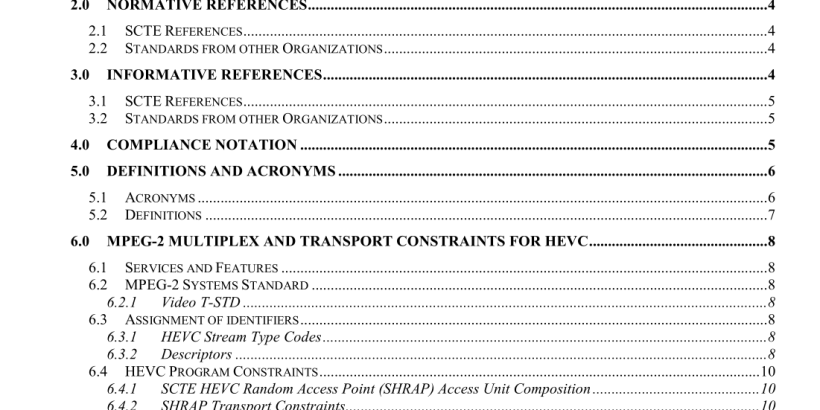ANSI SCTE 215-2-2018 pdf download.HEVC Video Constraints for Cable Television
1.0 SCOPE
This document defines the transport constraints on ITU-T Rec. H.265 | ISO/IEC 23008-2 [8] video compression (hereafter called “HEVC”) for Cable Television. In particular, this document describes the transmission of a single HEVC coded video elementary stream constrained per SCTE 215-1 [2] over MPEG-2 transport (ISO/IEC 13818-1 [7] for linear delivery systems supporting ad insertion services [5]. Beyond linear delivery with DPI, signaling is provided for segmentation of contents for xDVR applications. NOTE 1: The carriage of video in the MPEG-2 service multiplex is described in SCTE 54 [1].
1.1 Background (Informative)
This document specifies the transport of an HEVC coded video elementary stream constrained per SCTE 215-1 [2] intended for cable video services. There are other applications such as time-shifting (e.g., PVR/DVR service), Video- on-Demand services, and splicing (e.g., Ad-insertion) that could employ the specifications in this document. However, constraints specific to those applications are outside of the scope of this document at this time.
2.0 NORMATIVE REFERENCES
The following documents contain provisions, which, through reference in this text, constitute provisions of this document. At the time of Subcommittee approval, the editions indicated were valid. All documents are subject to revision; and while parties to any agreement based on this document are encouraged to investigate the possibility of applying the most recent editions of the documents listed below, they are reminded that newer editions of those documents might not be compatible with the referenced version.
6.1 Services and Features
This section describes additional services and features details pertaining to HEVC. NOTE 2: As described in SCTE 54 [1] and other SCTE standards, the MPEG-2 Transport provides services and features enabled by information carried at the MPEG-2 Transport multiplex level and not at the video elementary stream component level. Some of these services are System Information and Program Guide, Emergency Alerts, and Specification of Private Data Services. NOTE 3: The bitrate value for the HEVC Bitstream is application dependent and limited by the contiguous bandwidth of the transmission channel. In the application of HEVC transmission over a 64-QAM channel, bitrate value in combination with other bitstreams in the MPEG-2 Transport multiplex, conforms to a channel bitrate of less than or equal to 26.97 Mbps; in transmissions over a 256- QAM channels to less than or equal to 38.81 Mbps [12].
6.4.2.1 TS Packet Header and Adaptation Field Constraints
A TS packet containing the first byte of a PES packet header of an SHRAP shall have an adaptation field. The payload_unit_start_indicator bit shall be set to ‘1’ in the TS packet header and the adaptation_field_control bits shall be set to ‘11’(as per ISO/IEC 13818-1 [7]). In addition, the random_access_indicator bit in the adaptation field of the TS packet that contains the first byte of the PES packet header containing the SHRAP shall be set to ‘1’ and shall follow the constraints as specified in ISO/IEC 13818-1 [7] in Subclause 2.4.3.5. Per ISO/IEC 13818-1 [7], the elementary_stream_priority_indicator bit shall be set to ‘1’ in the adaptation field of the TS packet that contains the first slice start code of the SHRAP Picture. The first byte of the PES Packet Header containing an SHRAP and the first byte of the first slice start code of the SHRAP picture shall occur either in the same TS packet or in successive TS packets of the same PID. If both occur in the same TS packet, then both the random_access_indicator and elementary_stream_priority_indicator bits shall be set to ‘1’ in the adaptation field of this TS packet. If the first byte of the PES header and the first slice start code of the SHRAP picture occur in successive TS packets of the same PID, then both TS packets shall contain adaptation fields. The first TS packet adaptation field shall contain random_access_indicator = 1. The second TS packet shall contain elementary_stream_priority_indicator = 1. NOTE 5: Setting of both a random_access_indicator and elementary_stream_priority_indicator bits for the access unit signifies an SHRAP access unit. NOTE 6: Multiple PPSs may be present in an SHRAP access unit. The number of PPSs that may be present in an SHRAP access unit is constrained by the TS packet restrictions above (requiring both RAI and ESPI bits set in either the same TS packet or of successive TS packets).ANSI SCTE 215-2-2018 pdf download
